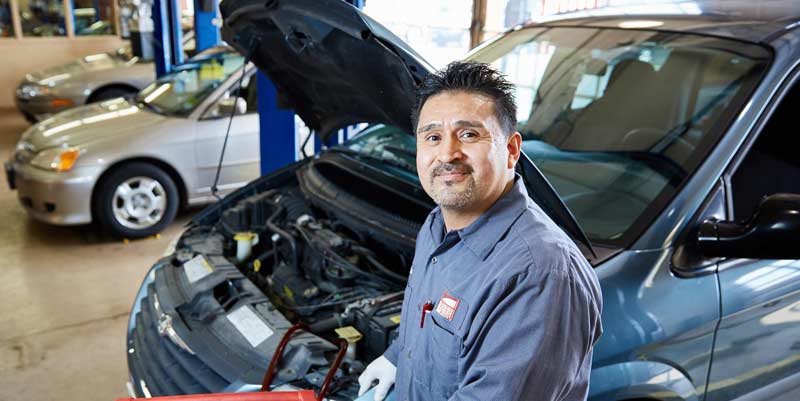Does My Car REALLY Need a Coolant Flush?

These are two very common questions, and they both have different answers, which can make this seem all the more confusing.
Let’s take a few minutes to talk about the coolant in your vehicle and whether you should go for a flush, a drain and replace, or neither one.
Changing Laws, Cars and Demands
Some vehicle owners manuals may not mention changing the coolant, which may lead some to believe that it never needs to be done. This is not true. However, it is true that modern cars don’t need to replace or flush their coolant as often as older models.
This is because lawmakers and the public have gradually increased demands that manufacturers make cars more environmentally friendly. This leads to fewer coolant changes.
For example, Hyundai only recommends changing the coolant after 60,000 miles. Mercedes-Benz recommends every 30,000 miles on some models and 120,000 on others.
Let’s not forget those “lifetime” coolant that you may have seen advertised. If you read the fine print, “lifetime” generally means between 30,000 and 50,000 miles.
This can all be confusing and the reason why many people simply don’t flush or change their coolant until a repair makes it necessary.
Why Change the Coolant at All?
While most manufacturers recommend thousands of miles before changing your coolant, there are plenty of reasons why it should be done. Sometimes, it can be more frequently than you think.
First, coolant can and does deteriorate over time. It’s always a good idea to have your trusted mechanic test the coolant to ensure that it is still working properly. This is difficult to tell simply by looking at the color. Your mechanic will have a small device that looks like a thermometer (called a hydrometer) that can determine the coolant condition.
When coolant deteriorates, it becomes more acidic and no longer protects your vehicle from rust. This causes damage to every part your coolant touches, from the heater core to the water pump, and even the radiator.
If your vehicle has more than 50,000 miles, it’s a good idea to have the condition of your coolant checked.
Second, if you have had any type of repair on the cooling system, the cooling system of your engine was exposed to air or other contaminants. This includes replacing hoses, radiator work, and water pump work. It also means coolant was added to your vehicle. If the engine wasn’t properly flushed of coolant at that time, you have a mix of both old and new coolant. This could mean that the old coolant is “worn out” and diluting the new coolant. This can cause the entire cooling system to not be as efficient as it could be.
Different Types of Coolant and Colors
Have you noticed that some coolants are green while others are pink? There is an important distinction between the two.
As coolant changed over the years, the industry used different colors in hopes of making “topping off” or adding coolant easier. It is VERY important that you use the correct one for your vehicle, especially if repairs were done and extra coolant was added. Hopefully, the person who worked on your vehicle before used the correct coolant and didn’t mix two different types. Mixing coolants can be an expensive mistake.
For example, the orange colored Dex-cool antifreeze should NEVER be mixed with the green glycol-based antifreeze. Mixing these two causes them to create a pudding-like mess that won’t circulate and certainly won’t protect your vehicle from overheating.
This is yet another reason to have your vehicle serviced by a trustworthy mechanic who understands which antifreeze is appropriate for your vehicle.
Flush or Drain and Replace
When you simply drain and replace, the only coolant you are changing is what is inside the radiator, the overflow reservoir, and possibly a bit that is inside the radiator hoses. This is less than half of what is inside your engine.
You can’t drain all the coolant from your car as you can with oil. To remove all of the coolant, a machine needs to be hooked up to the vehicle so it can force out the old coolant. This is usually called a coolant flush and is far more effective at removing all of the old, dirty coolant from your vehicle. It’s also a better value for your money.
In a Nutshell
In the end, flushing the old coolant from your vehicle is cheap insurance, especially when you consider the cost of a new radiator or water pump.
Have a trusted mechanic measure the protection of the coolant in your vehicle if you have 50,000 or more miles on your vehicle or if you have had some type of repair done on the cooling system and you have doubts about the coolant that was used or its condition.
When/if you need to replace the coolant, don’t waste money on a drain and replace. Be sure all of the old coolant is flushed from the system to ensure a clean, well-protected car.
The ASE-Certified mechanics at Hong Kong Auto Service will be happy to check the condition of your cooling system and coolant. This way, you can be sure not to run into overheating problems or unexpected repairs from damaged hoses or other parts.
Call us today at 847-251-0300 for an appointment or schedule online. Happy motoring!
